DODGE DART 2015 PF / 1.G Manual PDF
Manufacturer: DODGE, Model Year: 2015, Model line: DART, Model: DODGE DART 2015 PF / 1.GPages: 664, PDF Size: 16.96 MB
Page 71 of 664
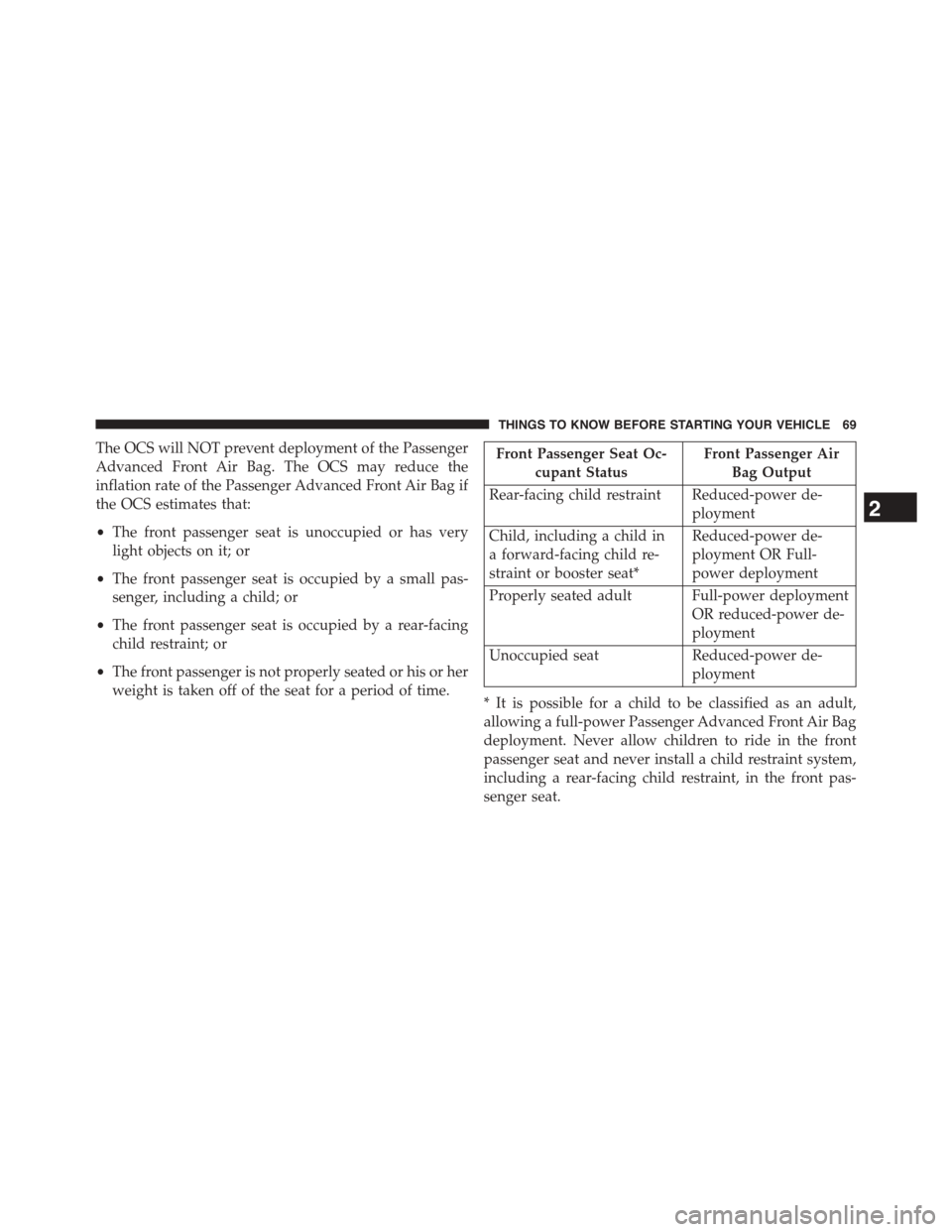
The OCS will NOT prevent deployment of the Passenger
Advanced Front Air Bag. The OCS may reduce the
inflation rate of the Passenger Advanced Front Air Bag if
the OCS estimates that:
•The front passenger seat is unoccupied or has very
light objects on it; or
•The front passenger seat is occupied by a small pas-
senger, including a child; or
•The front passenger seat is occupied by a rear-facing
child restraint; or
•The front passenger is not properly seated or his or her
weight is taken off of the seat for a period of time.
Front Passenger Seat Oc-
cupant Status
Front Passenger Air
Bag Output
Rear-facing child restraint Reduced-power de-
ployment
Child, including a child in
a forward-facing child re-
straint or booster seat*
Reduced-power de-
ployment OR Full-
power deployment
Properly seated adult Full-power deployment
OR reduced-power de-
ployment
Unoccupied seatReduced-power de-
ployment
* It is possible for a child to be classified as an adult,
allowing a full-power Passenger Advanced Front Air Bag
deployment. Never allow children to ride in the front
passenger seat and never install a child restraint system,
including a rear-facing child restraint, in the front pas-
senger seat.
2
THINGS TO KNOW BEFORE STARTING YOUR VEHICLE 69
Page 72 of 664
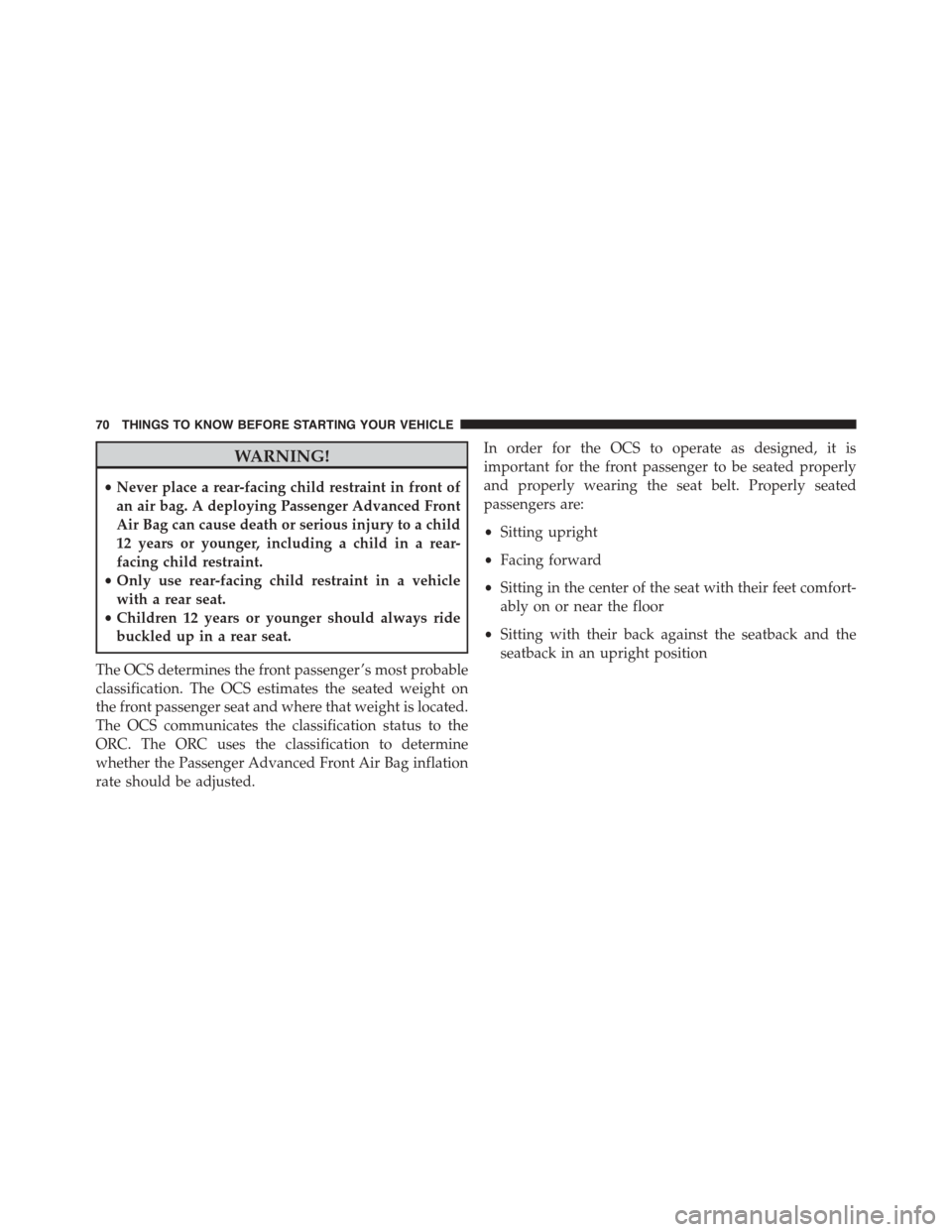
WARNING!
•Never place a rear-facing child restraint in front of
an air bag. A deploying Passenger Advanced Front
Air Bag can cause death or serious injury to a child
12 years or younger, including a child in a rear-
facing child restraint.
•Only use rear-facing child restraint in a vehicle
with a rear seat.
•Children 12 years or younger should always ride
buckled up in a rear seat.
The OCS determines the front passenger ’s most probable
classification. The OCS estimates the seated weight on
the front passenger seat and where that weight is located.
The OCS communicates the classification status to the
ORC. The ORC uses the classification to determine
whether the Passenger Advanced Front Air Bag inflation
rate should be adjusted.
In order for the OCS to operate as designed, it is
important for the front passenger to be seated properly
and properly wearing the seat belt. Properly seated
passengers are:
•Sitting upright
•Facing forward
•Sitting in the center of the seat with their feet comfort-
ably on or near the floor
•Sitting with their back against the seatback and the
seatback in an upright position
70 THINGS TO KNOW BEFORE STARTING YOUR VEHICLE
Page 73 of 664

Lighter Weight Passengers (Including Small
Adults)
When a lighter weight passenger, including a small adult,
occupies the front passenger seat, the OCS may reduce
the inflation rate of the Passenger Advanced Front Air
Bag. This does not mean that the OCS is working
improperly.
Do not decrease OR increase the front passenger ’s
seated weight on the front passenger seat
The front passenger ’s seated weight must be properly
positioned on the front passenger seat. Failure to do so
may result in serious injury or death. The OCS deter-
mines the most probable classification of the occupant
that it detects.
Seated Properly
2
THINGS TO KNOW BEFORE STARTING YOUR VEHICLE 71
Page 74 of 664
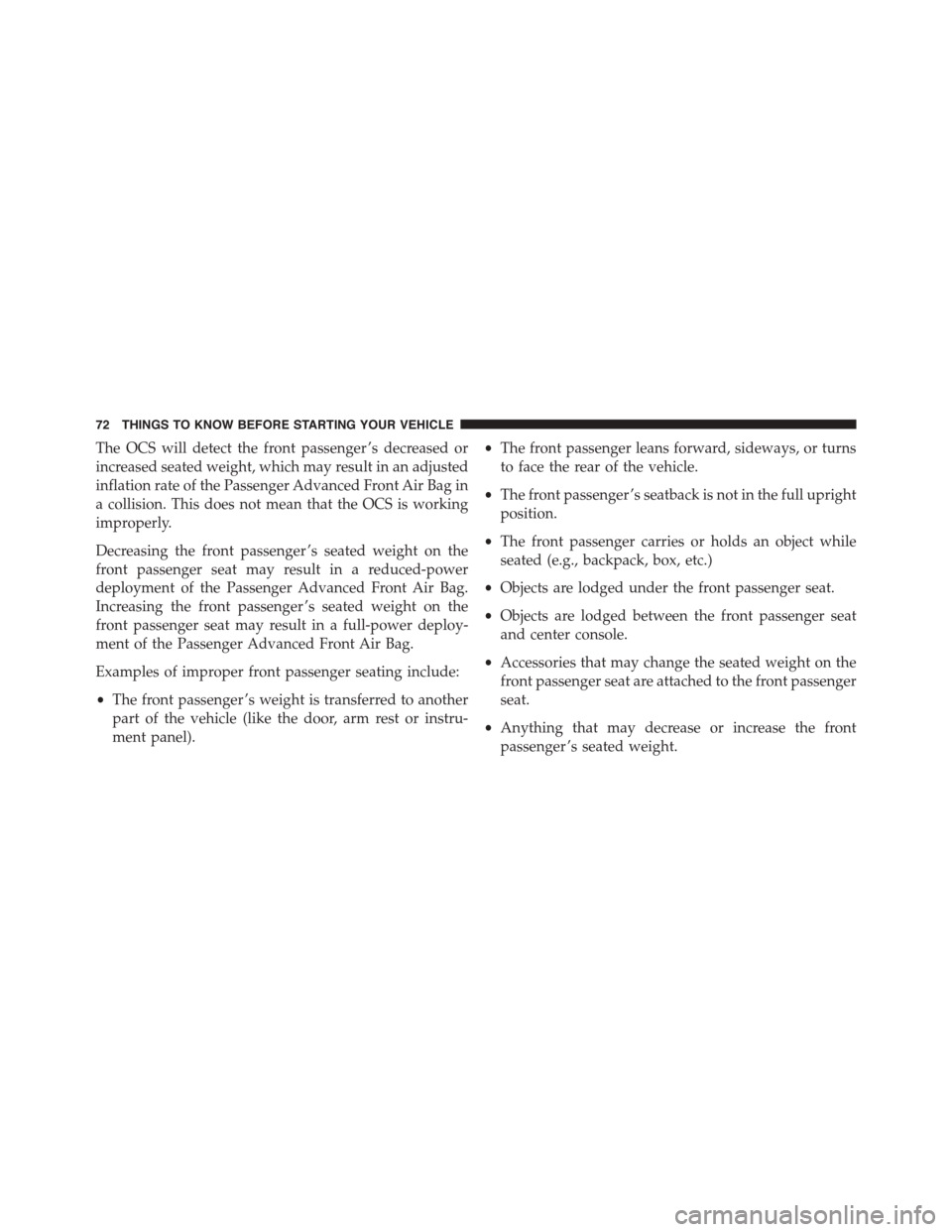
The OCS will detect the front passenger ’s decreased or
increased seated weight, which may result in an adjusted
inflation rate of the Passenger Advanced Front Air Bag in
a collision. This does not mean that the OCS is working
improperly.
Decreasing the front passenger ’s seated weight on the
front passenger seat may result in a reduced-power
deployment of the Passenger Advanced Front Air Bag.
Increasing the front passenger ’s seated weight on the
front passenger seat may result in a full-power deploy-
ment of the Passenger Advanced Front Air Bag.
Examples of improper front passenger seating include:
•The front passenger ’s weight is transferred to another
part of the vehicle (like the door, arm rest or instru-
ment panel).
•The front passenger leans forward, sideways, or turns
to face the rear of the vehicle.
•The front passenger ’s seatback is not in the full upright
position.
•The front passenger carries or holds an object while
seated (e.g., backpack, box, etc.)
•Objects are lodged under the front passenger seat.
•Objects are lodged between the front passenger seat
and center console.
•Accessories that may change the seated weight on the
front passenger seat are attached to the front passenger
seat.
•Anything that may decrease or increase the front
passenger ’s seated weight.
72 THINGS TO KNOW BEFORE STARTING YOUR VEHICLE
Page 75 of 664
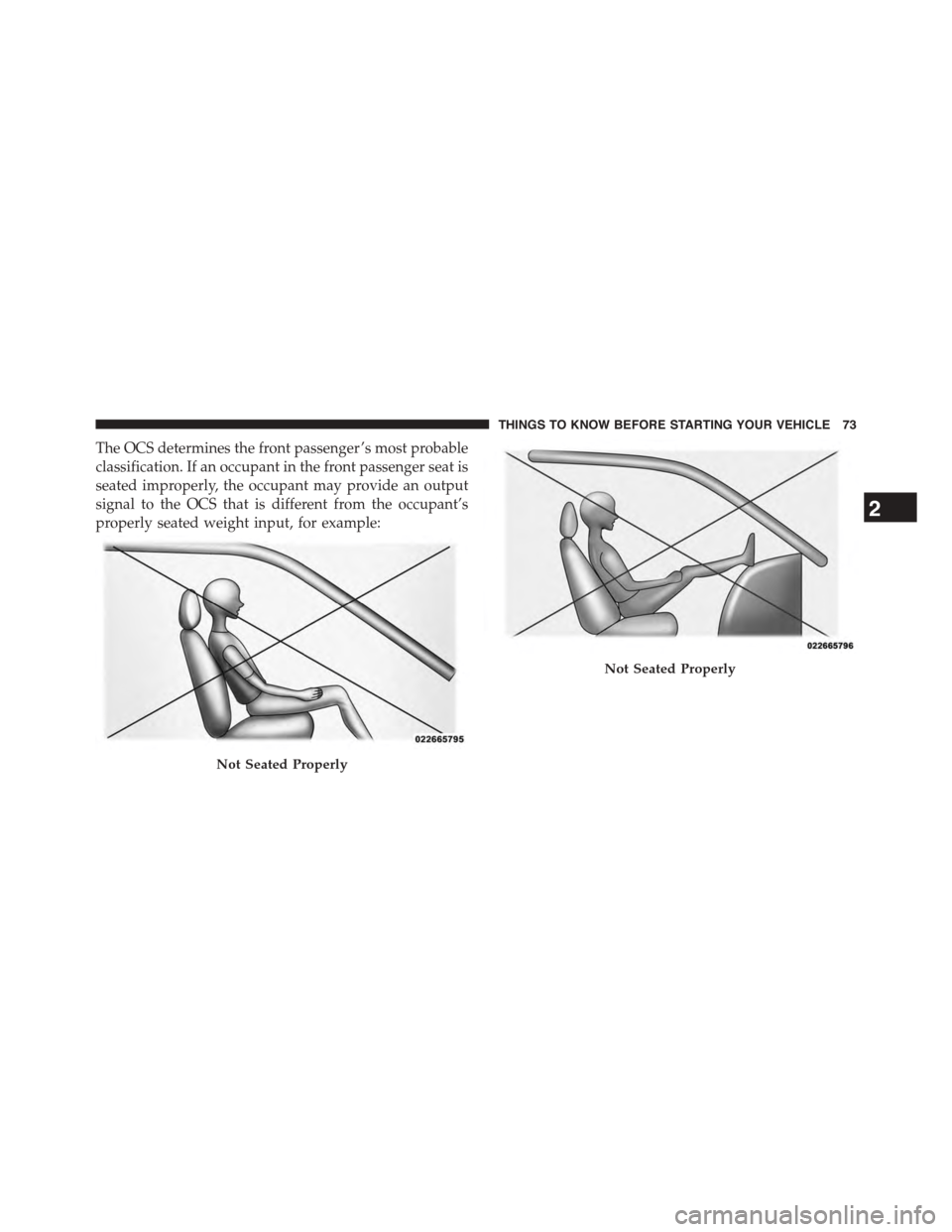
The OCS determines the front passenger ’s most probable
classification. If an occupant in the front passenger seat is
seated improperly, the occupant may provide an output
signal to the OCS that is different from the occupant’s
properly seated weight input, for example:
Not Seated Properly
Not Seated Properly
2
THINGS TO KNOW BEFORE STARTING YOUR VEHICLE 73
Page 76 of 664
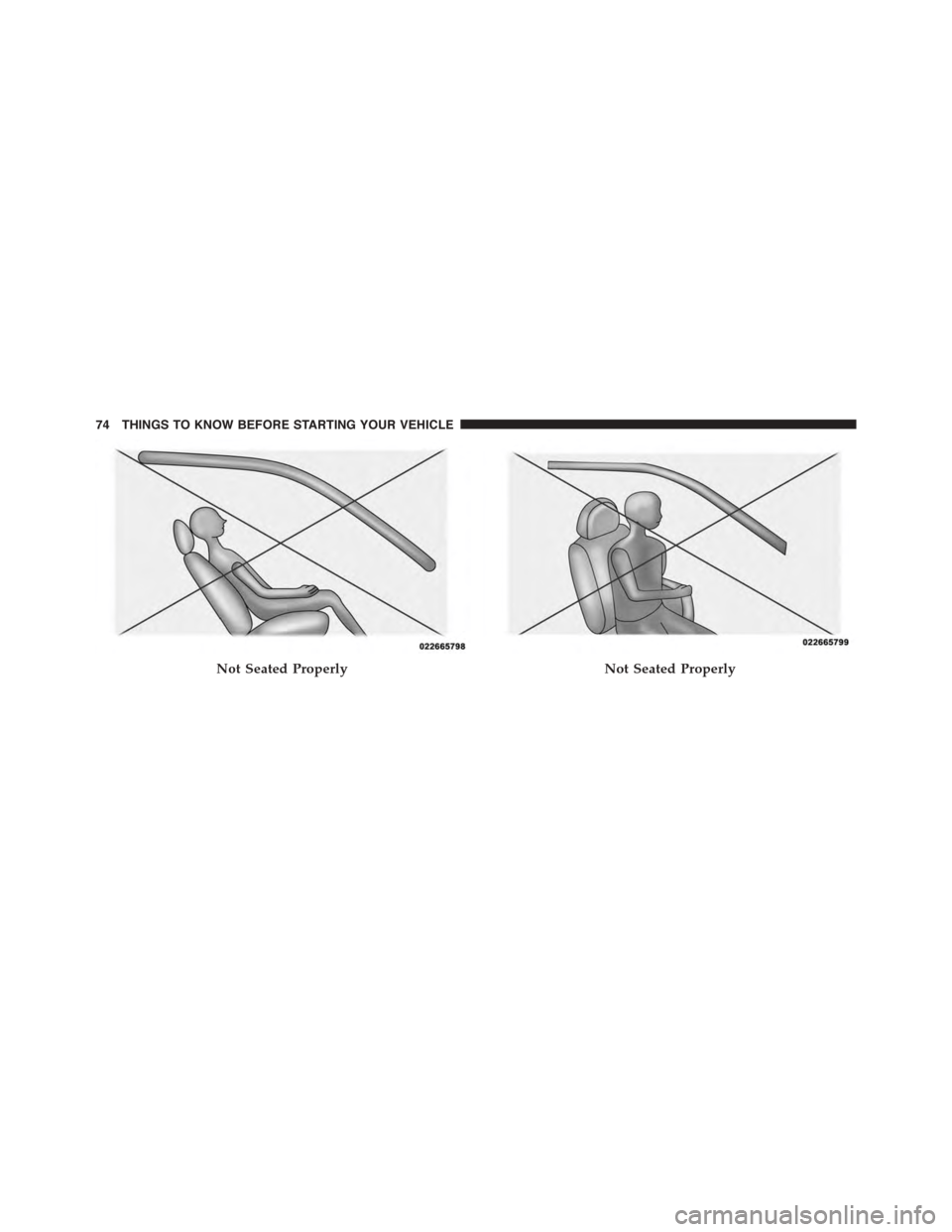
Not Seated ProperlyNot Seated Properly
74 THINGS TO KNOW BEFORE STARTING YOUR VEHICLE
Page 77 of 664

WARNING!
•If an occupant in the front passenger seat is seated
improperly, the occupant may provide an output
signal to the OCS that is different from the occu-
pant’s properly seated weight input. This may
result in serious injury or death in a collision.
•Always wear your seat belt and sit properly, with
the seatback in an upright position, your back
against the seatback, sitting upright, facing for-
ward, in the center of the seat, with your feet
comfortably on or near the floor.
•Do not carry or hold any objects (e.g., backpacks,
boxes, etc.) while seated in the front passenger seat.
Holding an object may provide an output signal to
the OCS that is different than the occupant’s prop-
erly seated weight input, which may result in
serious injury or death in a collision.
(Continued)
WARNING!(Continued)
•Placing an object on the floor under the front
passenger seat may prevent the OCS from working
properly, which may result in serious injury or
death in a collision. Do not place any objects on the
floor under the front passenger seat.
The Air Bag Warning Lightin the instrument panel
will turn on whenever the OCS is unable to classify the
front passenger seat status. A malfunction in the OCS
may affect the operation of the air bag system.
If the Air Bag Warning Lightdoes not come on, or
stays on after you start the vehicle, or it comes on as
you drive, take the vehicle to an authorized dealer for
service immediately.
The passenger seat assembly contains critical OCS com-
ponents that may affect the Passenger Advanced Front
Air Bag inflation. In order for the OCS to properly
2
THINGS TO KNOW BEFORE STARTING YOUR VEHICLE 75
Page 78 of 664
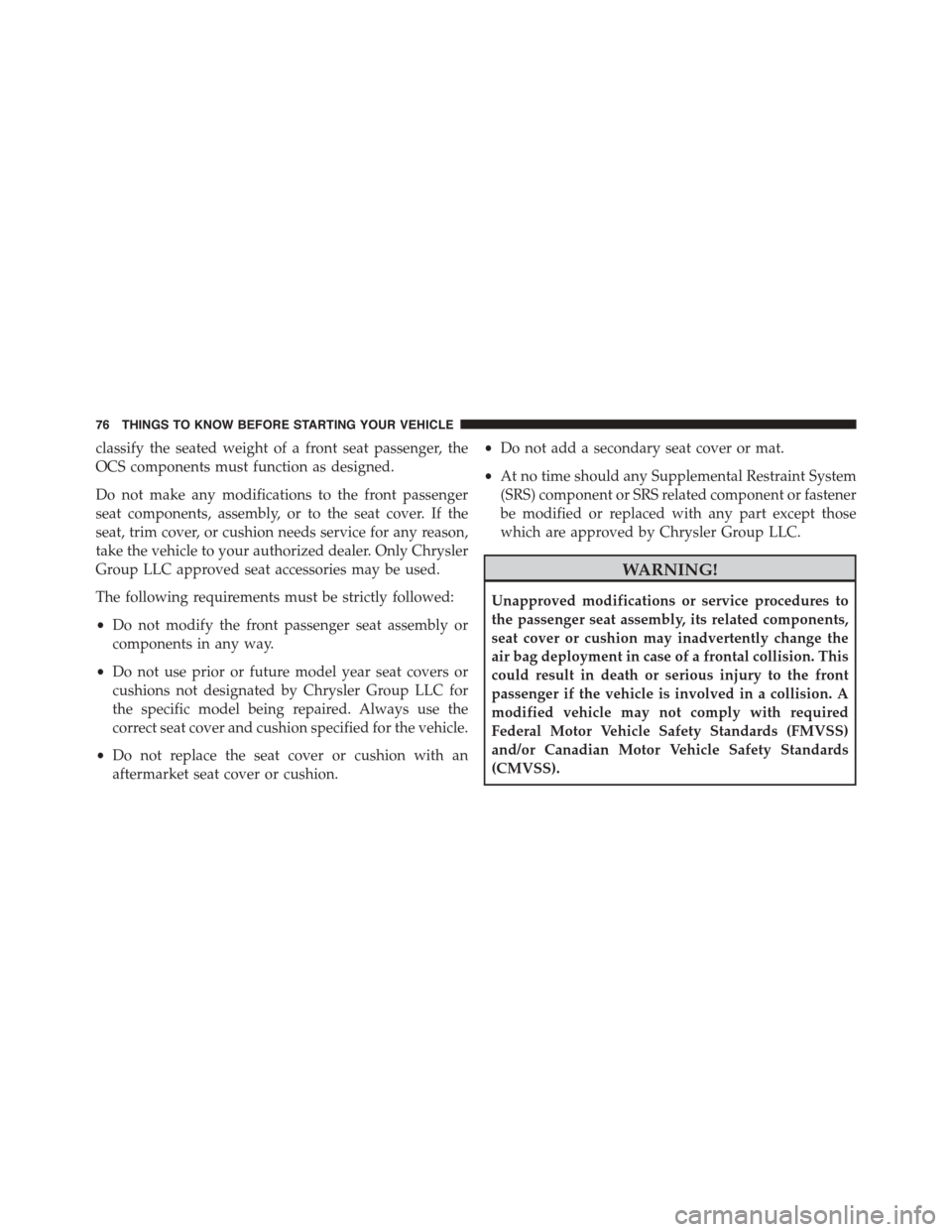
classify the seated weight of a front seat passenger, the
OCS components must function as designed.
Do not make any modifications to the front passenger
seat components, assembly, or to the seat cover. If the
seat, trim cover, or cushion needs service for any reason,
take the vehicle to your authorized dealer. Only Chrysler
Group LLC approved seat accessories may be used.
The following requirements must be strictly followed:
•Do not modify the front passenger seat assembly or
components in any way.
•Do not use prior or future model year seat covers or
cushions not designated by Chrysler Group LLC for
the specific model being repaired. Always use the
correct seat cover and cushion specified for the vehicle.
•Do not replace the seat cover or cushion with an
aftermarket seat cover or cushion.
•Do not add a secondary seat cover or mat.
•At no time should any Supplemental Restraint System
(SRS) component or SRS related component or fastener
be modified or replaced with any part except those
which are approved by Chrysler Group LLC.
WARNING!
Unapproved modifications or service procedures to
the passenger seat assembly, its related components,
seat cover or cushion may inadvertently change the
air bag deployment in case of a frontal collision. This
could result in death or serious injury to the front
passenger if the vehicle is involved in a collision. A
modified vehicle may not comply with required
Federal Motor Vehicle Safety Standards (FMVSS)
and/or Canadian Motor Vehicle Safety Standards
(CMVSS).
76 THINGS TO KNOW BEFORE STARTING YOUR VEHICLE
Page 79 of 664
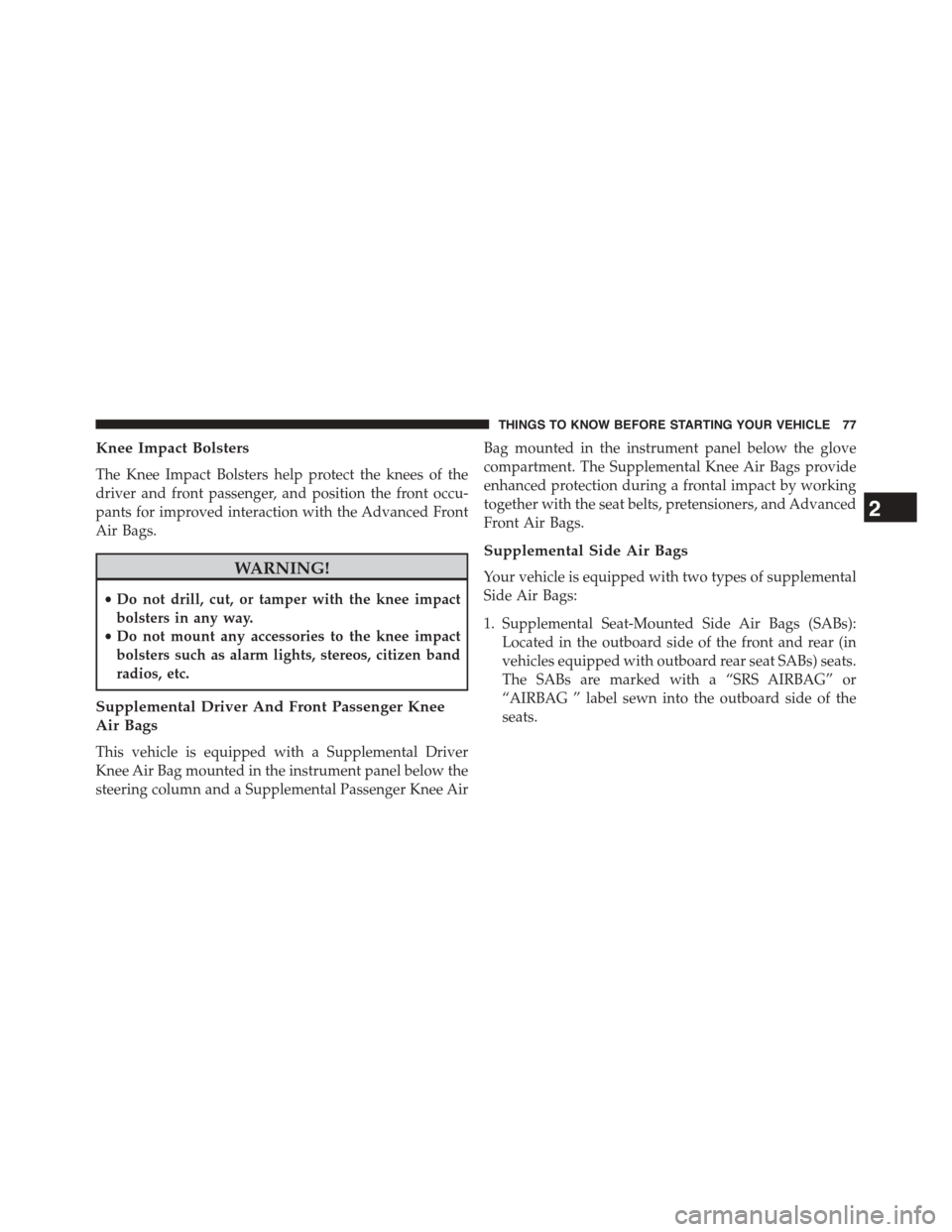
Knee Impact Bolsters
The Knee Impact Bolsters help protect the knees of the
driver and front passenger, and position the front occu-
pants for improved interaction with the Advanced Front
Air Bags.
WARNING!
•Do not drill, cut, or tamper with the knee impact
bolsters in any way.
•Do not mount any accessories to the knee impact
bolsters such as alarm lights, stereos, citizen band
radios, etc.
Supplemental Driver And Front Passenger Knee
Air Bags
This vehicle is equipped with a Supplemental Driver
Knee Air Bag mounted in the instrument panel below the
steering column and a Supplemental Passenger Knee Air
Bag mounted in the instrument panel below the glove
compartment. The Supplemental Knee Air Bags provide
enhanced protection during a frontal impact by working
together with the seat belts, pretensioners, and Advanced
Front Air Bags.
Supplemental Side Air Bags
Your vehicle is equipped with two types of supplemental
Side Air Bags:
1. Supplemental Seat-Mounted Side Air Bags (SABs):
Located in the outboard side of the front and rear (in
vehicles equipped with outboard rear seat SABs) seats.
The SABs are marked with a “SRS AIRBAG” or
“AIRBAG ” label sewn into the outboard side of the
seats.
2
THINGS TO KNOW BEFORE STARTING YOUR VEHICLE 77
Page 80 of 664
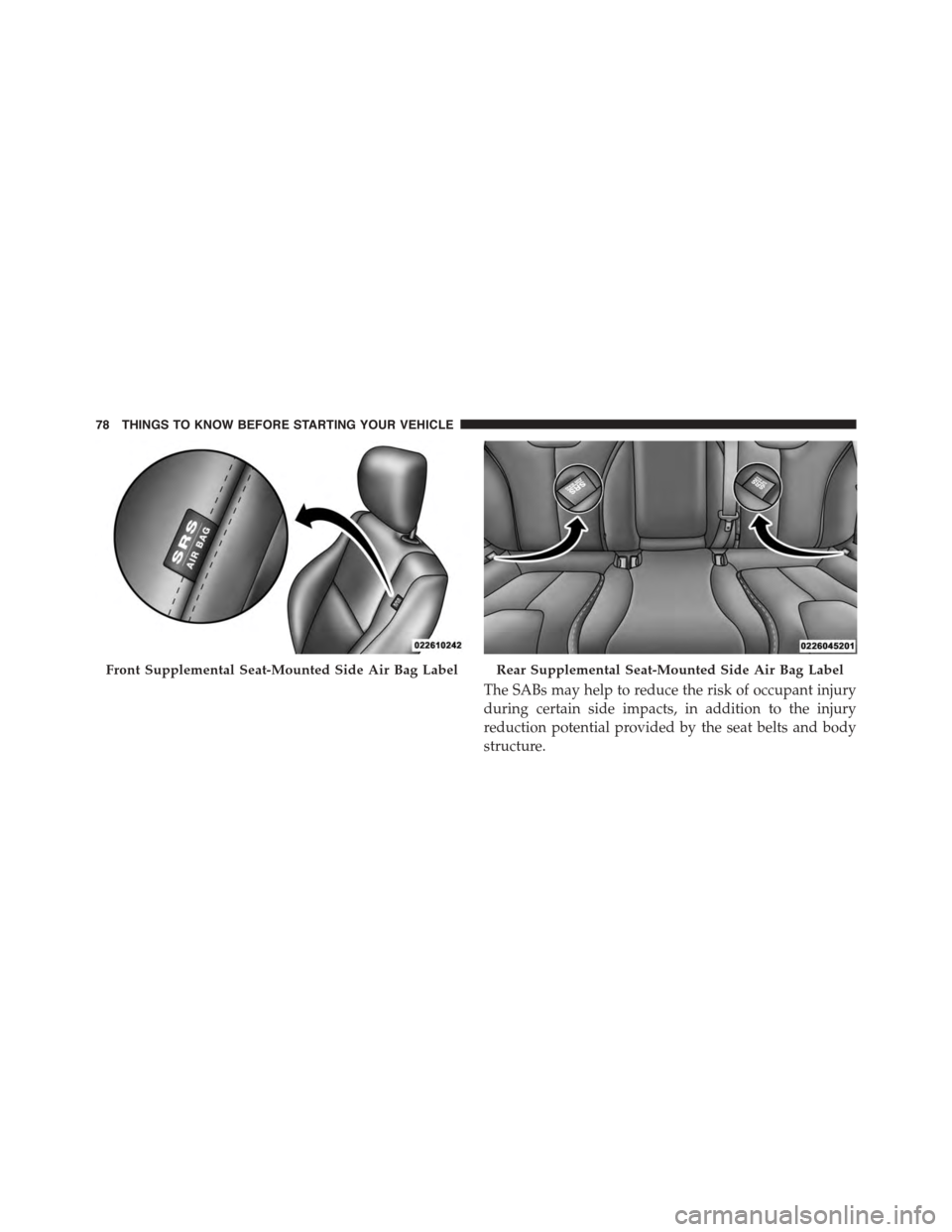
The SABs may help to reduce the risk of occupant injury
during certain side impacts, in addition to the injury
reduction potential provided by the seat belts and body
structure.
Front Supplemental Seat-Mounted Side Air Bag LabelRear Supplemental Seat-Mounted Side Air Bag Label
78 THINGS TO KNOW BEFORE STARTING YOUR VEHICLE